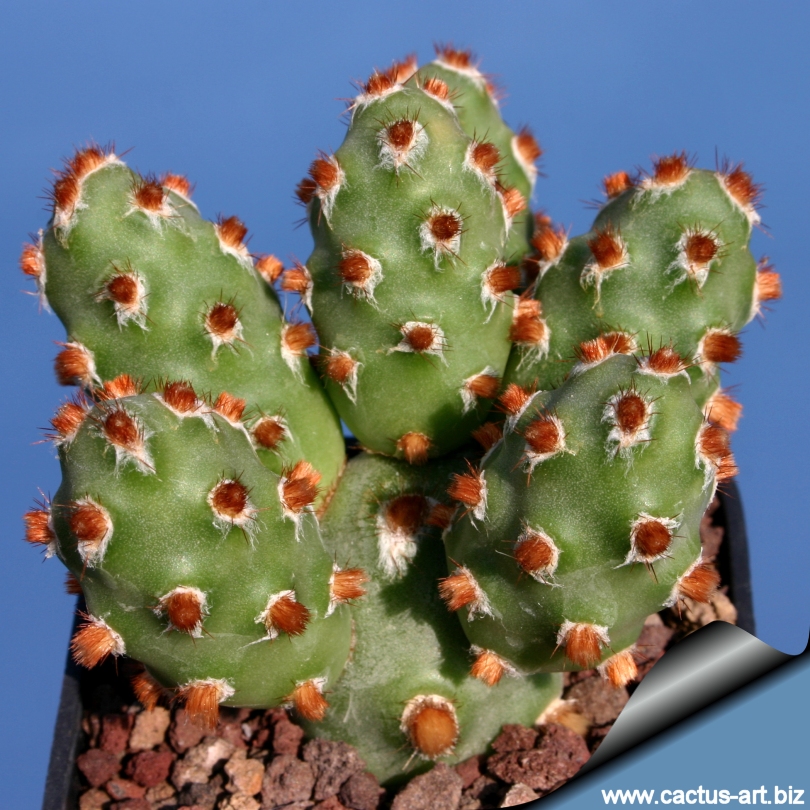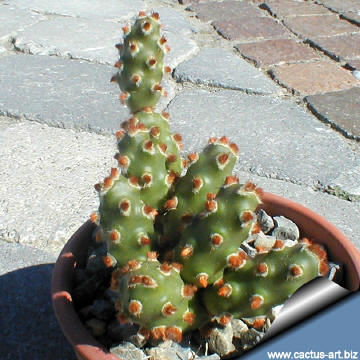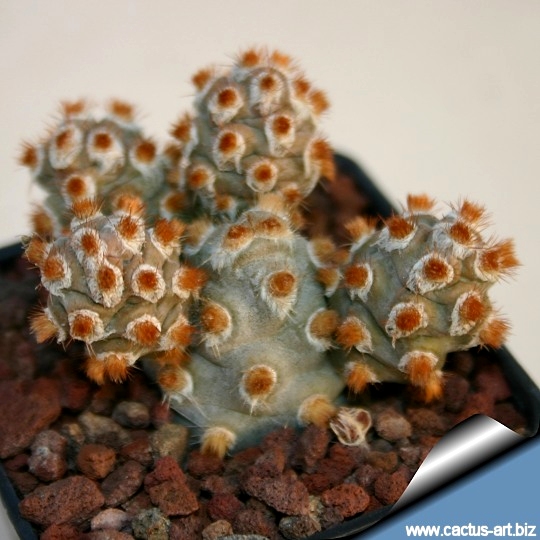|
|
|

Areoles with fox-red
glochids and white felt .
White blooms with a greener
throat.
|
|
 Morphology (Identifying
Characteristics): Small
clumping
segmented
succulent, In cultivation grows as a small erect
segment chains. In
habitat the plants stay smaller because the uppermost
segments are
detachable and drop easily. Morphology (Identifying
Characteristics): Small
clumping
segmented
succulent, In cultivation grows as a small erect
segment chains. In
habitat the plants stay smaller because the uppermost
segments are
detachable and drop easily.
Areoles : Very ornamental with bright yellow-brown
glochids and white
felt.
Spines:
Spineless.
Flower: Dirty white or very pale pink a little
hyaline with a green centre and green
filaments.
Pericarp is comparatively small and has areoles furnished with
bristle-like
spines as strong as the one on the young
shoots.


|
|
Photo of conspecific taxa, varieties, forms and
cultivars of Tephrocactus molinensis:Description: This
is a small soft-skinned succulent mesemb much like a Pleiospilos.
Tanquana hilmarii is the smallest species of the genus. In its
native habitat it tends to remain unmbranched but often clusters in
cultivation.
Body: Small, up to 35 mm (or more in cultivation) smooth soft to
the touch which are not at all lumpy or rock like as in pleiospilos,
brown-purplish to green-grey, dots all over, leaves are ovoidal- clavate
(triangular with fat rounded tips) and never keeled.
Flower: Solitary, diurnal, yellow 25-35 mm wide producing a
strong spicy scent.
Blooming season: Autumn, flowers opens in the afternoon and close at
night.
Fruit: Capsule 10-locular with covering membranes and small
closing bodies, and similar to those of Titanops hence the
extraction of this genus from Pleiospilos.
|
|
Advertising
|
|
|
|
Family:
Cactaceae (Cactus
Family)
Scientific Name:
Tephrocactus molinensis
(Speg.) Backeb. 1953
|
|
Distribution: Argentina (Salta, Los Molinos)
Habitat: Grows a
open area among wide spread Trichocereus pasacana.
Notes: At the end of the
dry season the
cladodes are very
dehidrated and plants
retract almost at
soil level.
Type:
Exsiccata:
“Opuntia schumannii-Tephrocactus
molinensis” (LPS 14335).
Lectotype designated by Kiesling (1984a: 230, as
type). Corp.
Basionym:
Opuntia molinensis Spegazini.
Published in:
Anales Soc. Ci. Argent. 96: 63.
1923,
nom. nov.
prop. Opuntia schumannii
Speg. in Anales Mus. Nac.
Buenos Aires 11 (ser. 3, 4): 511. 1905,
nom illeg. (non
F. A. C. Weber).
Protologue:
“Hab.
Semel abunde prope Molinos,
Prov.
Salta”.
Photographs: LP: without data. Later,
Spegazzini (1925: 102) published this photograph, although he did
not mention if it corresponds to the type.
Obs.: Spegazzini (1923) created a new name:
“Opuntia molinensis Speg. (nom.
nov.) = O.
Schumanni
Speg. (non Web.), Cactacearum
platensium
tentamen, nº 106”,
since the name
Opuntia schumanni
was already created by Weber in 1904.
Etymology: The
genus name
"Tephrocactus"
derives from the Greek adjective “tephros (τεφρος)”
meaning “ash coloured” plus the connective vowel
“o” used in botanical Latin for Greek words , and the
word “cactus” (an old genus name) (The genus name implies:
“ash coloured cactus”). The
species name "molinensis" comes from "Los
Molinos", name of the original location from which
the species is native.
Synonyms:
- Opuntia glomerata andicola
- Opuntia molinensis
- Maihueniopsis molinensis]
|
|
|
|

A plant during the winter resting period.
|
|